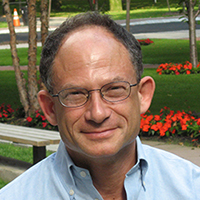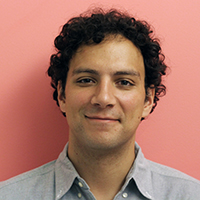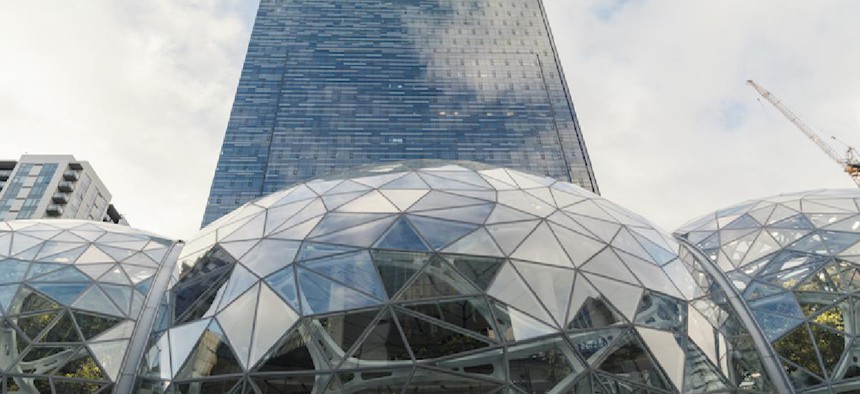In September, Amazon announced that the company would be seeking a second headquarters, dubbed HQ2, outside of its main campus in Seattle, Washington. Soon after the announcement was made, the de Blasio administration immediately signaled that New York City would be submitting a bid to host the headquarters.
New York City appears to have a strong case to host Amazon based on the company's stated criteria for a host city: proximity to mass transit and universities, international airport and highway access and a diverse, qualified workforce. But while Amazon would certainly bring thousands of jobs and bolster New York City's tech community, some economists and urban planners question whether the city should acommodate the multi-billion dollar corporation with tax subsidies to boost its bid; particularly if those subsidies aren't tied to significant community investments.
With the deadline for host cities to bid on the headquarters looming on Oct. 19, we asked three experts to make their argument for or against New York City hosting Amazon's HQ2.
RELATED: 'Brooklyn Prime' campaign aims to bring Amazon to NYC
Amazon needs to deliver better jobs, training and housing to New Yorkers
 By Adam Friedman
By Adam Friedman
Amazon has put out a call for cities to offer space and financial incentives for its second headquarters, which, the company says, will someday employ 50,000 in 8 million square feet of new office space. Cities across the United States and Canada are now bidding for that prize and it appears New York City is no exception.
Amazon’s projection of 50,000 jobs sounds like a big prize but New York might do just as well without it. That number is over 17 years or less than 3,000 jobs per year. New York has actually been adding an average of 23,500 jobs quarter since 2009. While capturing Amazon might be a big public relations benefit there would be a cost in financial incentives that would have to be paid by other businesses. New York would gain greater economic stability by adding 100 businesses employing an average of 30 people without the cost of any tax benefits or incentives.
Plus the challenge in New York City is not creating new businesses; it’s helping them grow. New York is a great naturally occurring incubator. But we have a commercial space shortage that has led or is leading to zoning changes in East Midtown, the Garment Center, downtown Brooklyn and Long Island City and possibly East New York, the latest neighborhood to be proposed as a new office hub. Adding 8 million square feet for Amazon is not going to address our existing shortage.
Finally, the de Blasio administration has committed itself to pioneering a model for more equitable economic growth – i.e. providing good jobs that are accessible to New York’s extraordinarily diverse workforce – and it is hard to see how Amazon is going to advance that unless the city extracts commitments from the company to engage in new ways with the existing communities.
While capturing Amazon might be a big public relations benefit there would be a cost in financial incentives that would have to be paid by other businesses.
There are some big obstacles to Amazon fitting into an equitable growth model. First, there is the skills mismatch and the lack of an infrastructure connecting our young adults to tech firms. A report by the Center for an Urban Future found that blacks and Hispanics make up only 9 percent and 11 percent of the tech workforce. Another study by CUNY’s Labor Market Information Service determined that people with college or graduate degrees held approximately 75 percent of the jobs in Brooklyn’s tech sector. But the high school graduation rate for blacks and Latinos in New York City is 65.4 percent and 64 percent respectively and only about one-third of these graduates meet CUNY college admission standards.
Creating jobs in high tech can exacerbate the growth in income disparity, which is already leading to the extraordinarily rapid changes and displacement we see in many neighborhoods. A study by Richard Florida showed that cities that “successfully” emphasized creative class strategies saw wage gains wiped out by increased housing costs for most of their residents.
Finally, Amazon may just be an online Walmart, creating few new jobs when cities factor in the loss elsewhere in their retail sector, what Greg LeRoy at Good Jobs First calls “retail churn.” Their warehouse jobs, for example, are generally non-union and pay less than $15 per hour.
If City Hall submits a bid, it should insist that Amazon work with our schools and community groups to maximize the synergy with and benefits to New Yorkers and neighborhoods. It should seek commitments on job quality and resident employment. It should work with schools to create new infrastructure to increase awareness of the array of opportunities opening up and build pathways into those careers. City Hall has begun to assemble some of the building blocks of this infrastructure, such as the Tech Talent Pipeline and Coding For All, but many more blocks are needed and Amazon should help deliver them. For example, the city could ask Amazon to commit to at least ten paid internships for high school students for every 100 employees and to work with teaches to develop curriculum and even co-teach classes to ensure that our students learn both the most relevant and current practices and substance for their future work environment.
Finally, the city and Amazon need to acknowledge how 50,000 new high tech office jobs may impact on housing in a city already facing a shortage and contribute to a fund that underwrites services to protect and create affordable housing.
Adam Friedman is the director of the Pratt Center for Community Development.
New York City has everything Amazon is looking for
 By Serkan Piantino
By Serkan Piantino
Amazon recently announced plans to open a substantial second headquarters somewhere in the country. It would be smart to plant its roots here in the Big Apple.
I helped Facebook open its New York office in 2010, and I know how valuable the enormous pool of talent here is. Despite increasing reliance on cloud storage, instant messaging and videoconferencing throughout business, most of us still need to get to an office every day to do our jobs. By opening a location here, Amazon and others can offer one of the most compelling employment benefits possible – the ability to live in New York.
New York City ought to be at the top of Amazon’s shortlist for “HQ2” for a simple reason: to unlock more potential Amazon employees than any other city, and by a wide margin.
To start, Amazon will likely want many of the 50,000 workers it hires to be software engineers. There are plenty of them here. New York City companies already employ more than 400,000 people in the software industry. And that number may continue growing, if New York continues to outpace all other cities outside Silicon Valley in high-tech venture capital.
But Amazon is not just a software business. It will need thousands of financial analysts, logistics experts, drivers, architects, factory workers, chefs and others to distribute hundreds of billions of dollars worth of products and services around the world. New York offers both the country’s largest pool of workers and its most diverse. Our workers draw from a wider range of experience and expertise here than anywhere else in the country, thanks to dozens of universities and our status as the center of multiple global industries. There’s even been a boom in local startups building hardware like drones and robots in places like New Lab, Industry City, and other industrial spaces around the city – technologies that will be especially interesting to Amazon.
New York City ought to be at the top of Amazon’s shortlist for “HQ2” for a simple reason: to unlock more potential Amazon employees than any other city, and by a wide margin.
New York is probably the greatest logistics testing ground that Amazon could hope for. It offers every conceivable environment in close proximity: dense high-rises, sprawling suburbs, huge complexes, walkable single-family-home neighborhoods, industrial stretches, even farms – and every gradation in between. We already have conventional delivery trucks, Amazon lockers and on-demand bike delivery throughout the city. And with New York City’s density, Amazon could refine new ideas here that wouldn’t be economically feasible anywhere else.
Splitting a company across multiple cities isn’t easy. Employees need to be able to collaborate effectively across large distances and multiple time zones. Leaders will need to spend time seeding a consistent company culture in their new outpost. Video conferencing can only do so much, and Amazon would be wise to encourage employees to visit their colleagues in other offices for the benefit of real face-to-face time. That’s easiest in New York, with 14 nonstop flights to Seattle daily (the most of any East Coast city) and many more to every international business hub. And given what the city offers in food, entertainment and culture, I don’t think there’s a more appealing place to spend a few days on business than New York City.
If it’s real estate they’re worried about, New York has that covered. Amazon wants 500,000 square feet ready for its new campus by 2019. Brooklyn, the Bronx, Queens, and Staten Island all have great spaces that could be developed and are worth a close look. In fact, several of Brooklyn’s real estate titans have uncharacteristically teamed up to woo Amazon. They could settle Amazon into a dense campus or, for instance, devise a constellation of locations along the Brooklyn-Queens waterfront, one of the fastest-growing parts of the city and one that should soon be connected with brand new transit in the form of the proposed Brooklyn-Queens Connector.
When we looked for a home for the next Facebook office in 2010, we found New York was the right choice to build a world-class software team. Amazon is a company that does almost everything: it’s a tech company, a retailer, a media studio, a logistics powerhouse, a grocer, an importer, a wholesaler, a manufacturer and a cloud provider. In the depth, diversity and sheer size of New York City, Amazon will find everything it’s looking for.
Serkan Piantino is an entrepreneur and technology leader in New York City, where he is on the board of Tech:NYC. He is the founder and CEO of Spell. Previously he was founder and site director of Facebook New York and co-founder of Facebook AI Research.
Amazon should come to New York City for the quality of life, not the subsidies
 By James Parrott
By James Parrott
Sometimes competition can be good. It certainly worked out pretty well for New York City when the Bloomberg administration set in motion a competition for a world-class engineering school to locate on Roosevelt Island. Cornell and Technion Universities won that competition, but New York City was also a winner since the competition bolstered the city’s stature as a fertile milieu for advanced technology enterprises.
The competition among cities to be the location for a second Amazon headquarters (HQ2) is intense and revealing, and generally positive in underscoring the importance of culture, community and quality of life – critical factors in the ability to attract and retain strong technical talent that is the paramount criterion.
Amazon already has demonstrated its keen interest in New York City in recently announcing a new 360,000-square foot facility in Hudson Yards that will house 2,000 high-paying finance, sales, marketing and IT jobs. This is in addition to a comparably sized administrative facility on 34th Street across from the Empire State Building, and a recently announced state-of-the-art distribution center that will bring 2,250 jobs to Staten Island.
The best way for the city (and state) to further enhance its attractiveness for new business investments is to stay focused on maintaining a high quality of life and its diverse and interesting neighborhoods. That includes investing in improving schools, public safety, mass transit and other infrastructure vital to environmental sustainability and affordable housing.
Tax subsidies are the essence of short-termism; a fleeting benefit at the expense of real investments. Such a management perspective is alien to Jeff Bezos.
Amazon is smart enough to know that those are the things that will help attract and retain innovative talent, not subsidies. It's even more important for New York City to keep itself attractive to innovative startups, in a range of tech, media, fashion, cultural and other fields. Subsidies to super-rich corporations undermine the city's commitment and capacity to do that. No one disputes the fact that such a startup-friendly environment is one of the best ways to attract top-flight technical talent.
Given the long term strategic basis for Amazon’s HQ2 location decision, it is doubtful that traditional economic development subsidies like tax breaks would play much of a role. Tax subsidies are the essence of short-termism; a fleeting benefit at the expense of real investments. Such a management perspective is alien to Jeff Bezos. Memorably, when he took the company public 20 years ago Bezos stated, “It’s all about the long term.”
New York City’s dense horizontal and vertical concentration and diversity of economic activities have long undergirded its productivity advantage. Traditional business cost comparisons that focus on pay levels, rents and taxes are basically meaningless since they do not capture the value of the production that results. Those facile comparisons may be easy to compile but they miss the productivity or efficiency and value of producing here. New York City is not a cheap place to do business, but there’s no place that’s capable of creating more value.
But New York’s attractiveness goes beyond traditional agglomeration economies having to do with business operations today. The dynamic synergies that flow from the proximity of leading-edge intellectual pursuits, academia, science, arts (all of them), culture (high, low and otherwise), media and social media, finance, fashion, advertising, marketing, and international and cosmopolitan values is unique to New York City. The continuous and random interactions of those disciplines breeds innovation. And that’s what attracts innovators here.
Whether or not Amazon selects New York City, it is clear that the smartest thing for the city and the state to do is to double down on investing in public schools, high quality and affordable public higher education, mass transit, affordable housing and environmental sustainability. And our leaders should continue to promote and protect our immigrant-friendly environment, our civil and human rights, and our democratic institutions. New York City has never wavered on those values and it’s mighty attractive for that reason.
James A. Parrott is the director of economic and fiscal policy at the New School’s Center for New York City Affairs.


